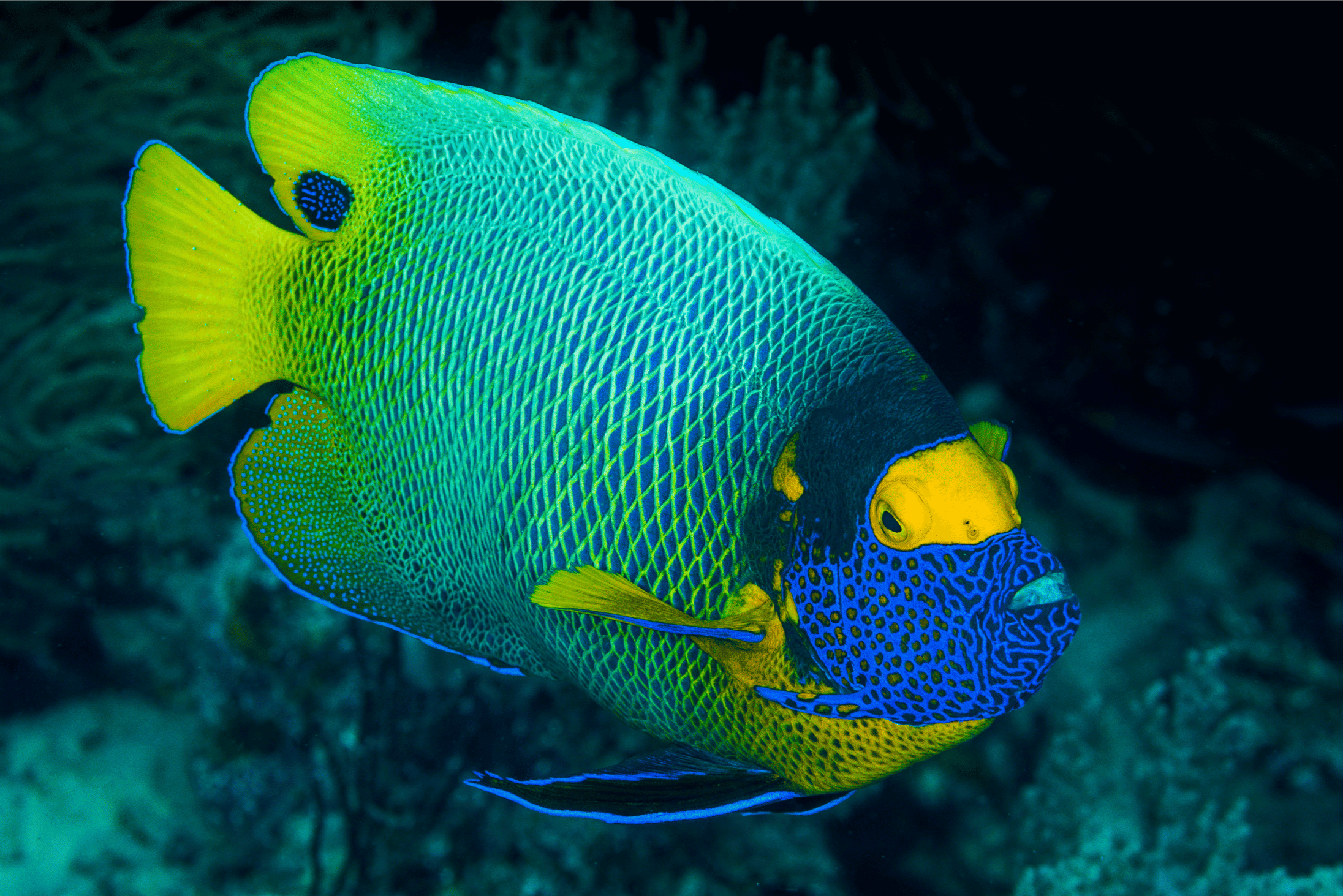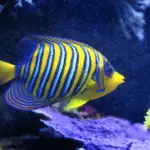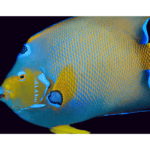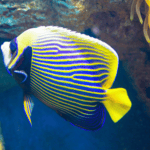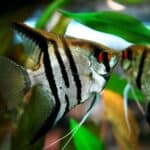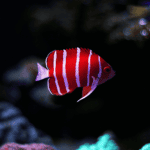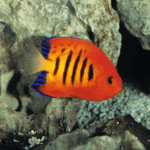The Masked Angelfish, known scientifically as Genicanthus personatus, is a species that demands attention due to its unique appearance and behavior. This species of marine angelfish is highly sought after in the aquarium trade for its striking coloration and graceful demeanor. Native to the Northwestern Hawaiian Islands, the Masked Angelfish is found in the deeper coral reefs, where it maintains a relatively sheltered existence.
Understanding the specific needs and behaviors of the Masked Angelfish is crucial for those who wish to keep these fish in home aquariums. Their diet in the wild consists of a variety of marine algae and zooplankton, which must be carefully replicated in captivity to ensure their well-being. Moreover, conservation efforts are significant for this species, which, while not currently endangered, is subject to the pressures of habitat disruption and the aquarium trade.
Key Takeaways
- The Masked Angelfish is a distinctive marine species, prized in the aquarium trade.
- Proper care in captivity requires attention to their natural diet and habitat needs.
- Conservation efforts are essential to mitigate the impacts of human activities on their populations.
Natural Habitat and Distribution
The masked angelfish, a species revered for its striking appearance, predominantly inhabits the remote waters of the Northwestern Hawaiian Islands. We will explore the specific geographical range of these fish and the particular habitat characteristics that they favor.
Geographic Range
The geographic range of the masked angelfish is quite limited, being found exclusively in the Pacific Ocean. Specifically, Hawaii’s Northwestern Hawaiian Islands are home to these elusive creatures. Significant populations are noted around:
- Midway Atoll
- Pearl and Hermes Reef
- Kure Atoll
This range does not extend to the main Hawaiian Islands, making the masked angelfish a species of particular interest due to its localized distribution.
Habitat Specifics
In terms of habitat, the masked angelfish prefers coral reefs. The species thrives in waters at various depths, but they are most commonly found at depths of 10 to 150 meters. The coral reef environments provide not only a rich source of food but also shelter against predators and strong ocean currents.
The specific locales, such as Pearl and Hermes Reef, support a diverse range of marine life and offer the structure and resources that masked angelfish necessitate for their survival. Consequently, the conservation of these reefs is crucial for the continuing existence of the masked angelfish within this restricted region.
Physical Characteristics and Behavior
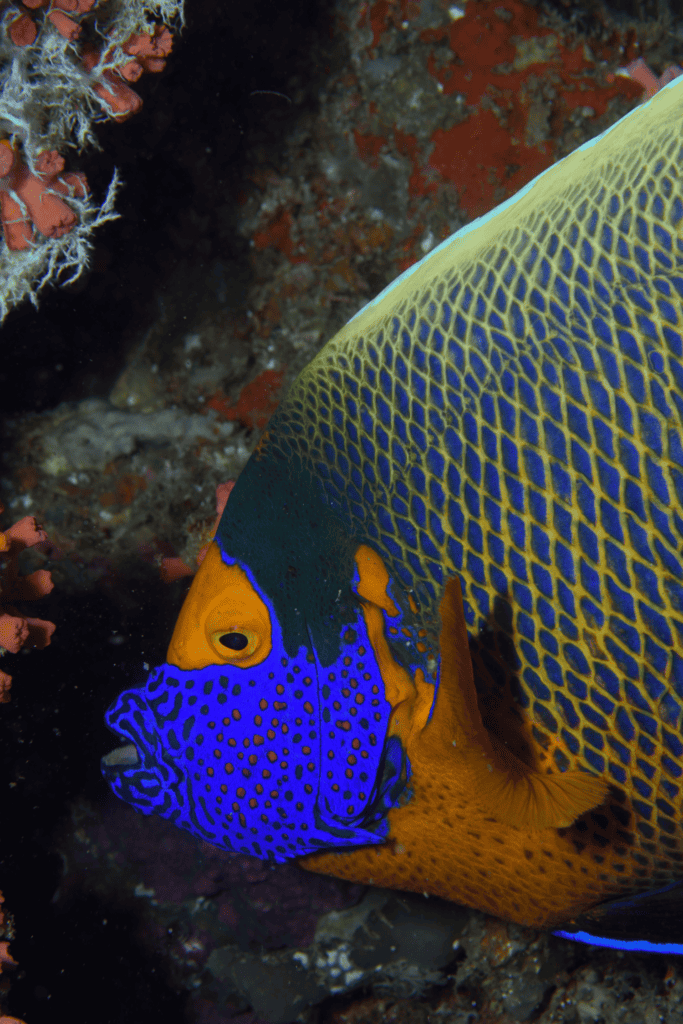
In discussing Masked Angelfish, scientifically known as Genicanthus personatus, we focus on their distinctive physical attributes and intriguing behaviors that make them unique in the marine world.
Identifying Features
The Masked Angelfish, residing in the family Pomacanthidae, boasts a graceful size reaching up to 8 inches (20 cm) in length. Adults typically exhibit a white to pale blue body complemented by a distinct black mask extending through the eye and a black patch on the gill cover. The caudal fin or tail is adorned with a thin vertical striping that enhances their elongated and flattened body shape.
Sexual Dimorphism and Reproduction
We observe conspicuous sexual dimorphism in this species; adult males are recognizable by their bold black facial mask contrasted with blueish-white lips. Females lack the pronounced mask and are generally more subdued in color. Masked Angelfish are protogynous hermaphrodites, meaning they have the ability to change sex from female to male under specific environmental conditions. This feature is particularly important for their reproduction strategy in maintaining social hierarchy and ensuring genetic diversity.
Social Behavior
Exhibiting a peaceful temperament, Masked Angelfish are reef fish that can often be seen patrolling their territories. They are inclined to be somewhat territorial but maintain amicable relations with other non-competing species. As sexually dichromatic creatures, they display different colors between the sexes, which plays a role in their behavior and social interactions within their habitat.
Dietary Habits and Aquarium Care
In maintaining the Masked Angelfish, we focus on their distinct feeding habits and specific aquarium requirements to foster health and longevity.
Feeding Preferences
Masked Angelfish thrive on a varied diet that primarily includes marine algae and invertebrates. To mimic their natural diet, we ensure to provide a balanced mix of:
- Algae: Marine algae are vital in their diet, as angelfish graze on it consistently.
- Mysis shrimp and brine shrimp: These provide the high-quality protein necessary for their growth and health.
- Zooplankton: It serves as an excellent source of nutrition, especially for juvenile angelfish.
- Clams: Offering small pieces can help in diversifying their diet.
It’s crucial for us to routinely provide these foods to ensure proper feeding.
Aquarium Requirements
When setting up an aquarium for Masked Angelfish, we consider the following elements to recreate their natural habitat:
- Minimum Tank Size: A tank of at least 100 gallons is advisable due to their size and need for swimming space.
- Live Rock: Incorporating live rock encourages natural grazing behavior and provides hiding spots.
- Temperature Range: Keep the water temperature stable, between 72-78°F to simulate their natural environment.
- Water Quality: Regular water changes are essential to maintain high water quality, which is crucial for the angelfish’s health.
By adhering to these parameters, we create a suitable and sustainable environment.
Health and Longevity
To ensure the health and longevity of Masked Angelfish in captivity, we must:
- Regularly check water parameters, since stable pH, nitrate, and ammonia levels are non-negotiable for their well-being.
- Observe their behavior and physical condition, as changes might indicate health issues.
- Reef Safe: Understand that while they are generally reef safe, they may nip at certain corals or invertebrates.
By proactive monitoring and care, we increase their lifespan and quality of life in the aquarium.
Conservation and Human Interaction
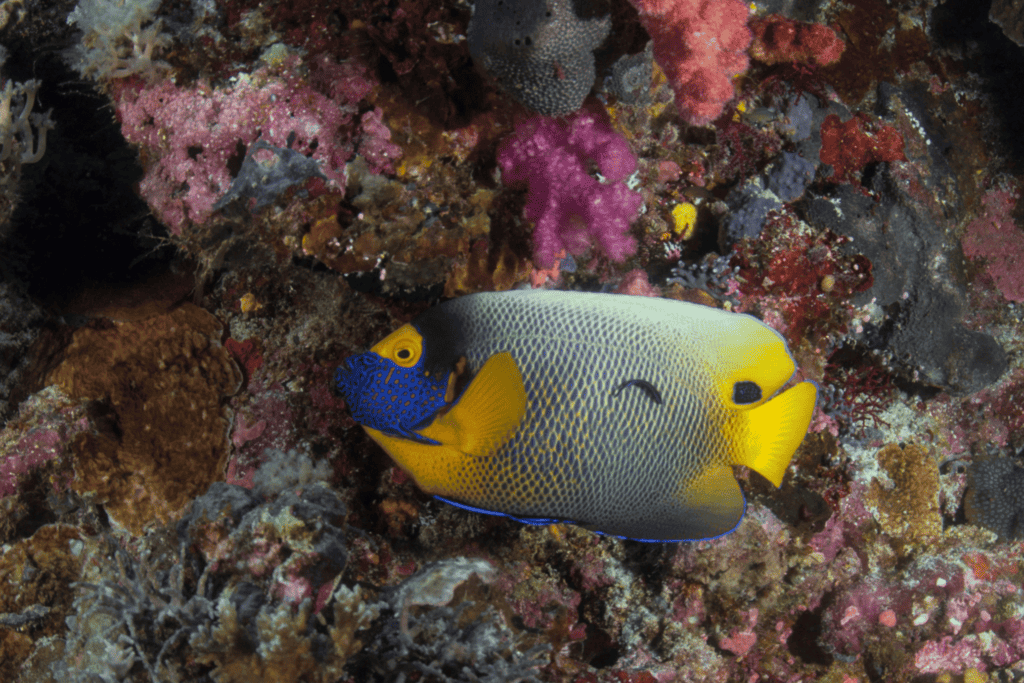
Masked Angelfish are a rare marine species, significant to both conservationists and rare fish collectors. We acknowledge their delicate status in the wild and the impact of human activities such as the aquarium trade on their populations.
Threats and Conservation Status
Genicanthus personatus, commonly known as the Masked Angelfish, faces several threats in its natural habitat. The primary concerns include:
- Habitat destruction: Coastal developments and pollution contribute to the degradation of coral reefs, which are critical to the survival of Masked Angelfish.
- Climate change: Rising sea temperatures and acidification of oceans due to increased levels of CO2 affect coral reef health, indirectly impacting the species that rely on them.
The conservation status of Masked Angelfish is currently Near Threatened according to the International Union for Conservation of Nature (IUCN). We are working with conservation organizations to monitor their populations and implement measures to preserve their natural habitats.
Aquarium Trade and Collecting
The availability of Masked Angelfish in the aquarium trade is a double-edged sword. On one hand, it provides enthusiasts the opportunity to maintain and appreciate this rare species within their own aquariums. On the other hand, over-collection can severely deplete their numbers in the wild.
- Limited Collection: To mitigate this, strict regulations on collecting these fish have been put in place.
- Captive Breeding: Efforts to breed Masked Angelfish in captivity are ongoing, aiming to reduce pressure on wild populations.
Aquariums and zoos often participate in captive breeding programs, ensuring a sustainable population for both conservation and educational purposes. Our role as responsible hobbyists or rare fish collectors is to support these efforts by prioritizing sustainably sourced Masked Angelfish and advocating for their conservation.
Cultural and Economic Impact
The Masked Angelfish, a species highly regarded for its beauty, has both an economic and cultural footprint, particularly in regions where it is indigenous or popular among aquarists.
Economic Relevance
The Masked Angelfish, known scientifically as Genicanthus personatus, commands premium pricing, particularly in the aquarium trade where enthusiasts admire its rarity and striking coloration. In the local economies of Hawaii, a state renowned for its diverse marine life, the sale of these fish contributes significantly to the income of fish collectors and businesses involved in the marine aquarium trade. Markets in places like Japan and Hong Kong often showcase the Masked Angelfish at high-end aquarium stores, where their exclusivity can fetch prices upwards of several thousand dollars per individual.
On the islands of Oahu and Kauai, the angelfish’s presence snorkeling and diving tours, adding value to Hawaii’s tourism sector. The allure of potentially observing a Masked Angelfish in its natural habitat enhances the appeal of these underwater excursions.
Cultural Significance
Culturally, the Masked Angelfish holds a special place in the hearts of many Hawaiians. It is endemic to the Northwestern Hawaiian Islands, which adds to its allure and symbolism for the region’s uniqueness and natural beauty. Its image is often used in local art and motifs, representing the rich biodiversity of Hawaii’s marine ecosystems.
The Waikiki Aquarium in Oahu promotes education and conservation of local marine species, including the Masked Angelfish. Through their exhibits, they provide visitors with a deeper appreciation of the cultural heritage associated with Hawaii’s marine life. The conservation efforts raised by the aquarium also highlight the importance of preserving the marine environment for future generations, reflecting the values and stewardship of the local community toward their natural resources.
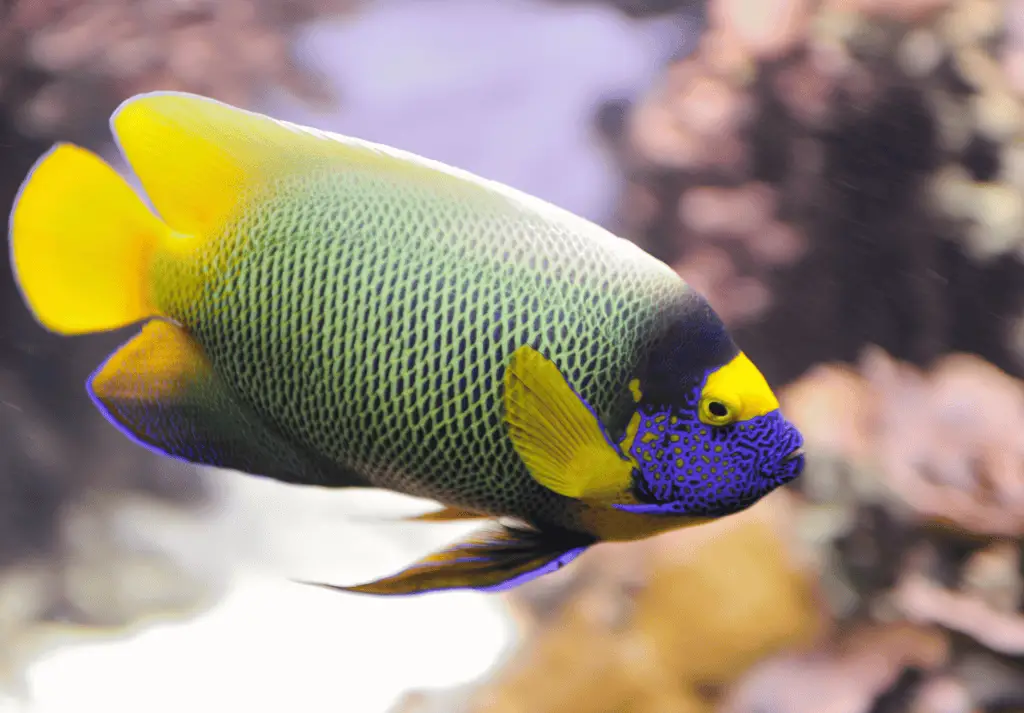
Frequently Asked Questions
In this section, we address common inquiries regarding the care, habitat, and behavior of masked angelfish, providing essential information for enthusiasts and aquarists.
What is the natural habitat of the masked angelfish?
The masked angelfish, Genicanthus personatus, is typically found in the Northwestern Hawaiian Islands. Its natural habitat is steep coral reef drop-offs, usually at depths ranging from 10 to over 150 meters.
What are the dietary requirements of masked angelfish in captivity?
In captivity, masked angelfish thrive on a variety of foods including marine sponges, tunicates, and a mix of meaty foods along with marine algae. It is crucial to maintain a balanced diet to ensure their health and coloration.
How does the masked angelfish behave in a community aquarium setting?
Masked angelfish are generally peaceful but can be territorial towards others of the same species. In a community aquarium, they are best kept with other non-aggressive fish and provided with ample space to establish their territory.
What specific water conditions are preferred by the masked angelfish?
Masked angelfish prefer water with a temperature range of 72-78°F, a pH between 8.1 and 8.4, and specific gravity of 1.020-1.026. Consistent water quality with low nitrogenous waste levels is essential.
Can masked angelfish be bred in captivity, and if so, how?
Breeding masked angelfish in captivity is challenging but not impossible. Success requires replicating their natural deep-water environment, ensuring optimal water quality, and providing a stress-free habitat with plenty of space and the right diet.
What are common health issues for masked angelfish in home aquariums?
Common health issues for masked angelfish in home aquariums include nutritional deficiencies, parasitic infections like marine ich, and stress-related diseases. Proper diet, quarantine of new arrivals, and stable, clean water conditions are vital for prevention.
